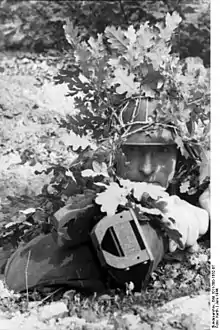Hafthohlladung
The Hafthohlladung, also known as the "Panzerknacker" ("tank breaker", German connotation "safe cracker"), was a magnetically adhered, shaped charge anti-tank grenade used by German forces in World War II, and was sometimes described as a mine.
| Hafthohlladung | |
|---|---|
 France / Belgium.- Soldier (camouflaged with oak leaves on the helmet) with adhesive hollow charge (Hafthohlladung) 3 HL lying in cover | |
| Place of origin | Germany |
| Service history | |
| In service | November 1942-May 1944 (some still used after this period) |
| Wars | World War II |
| Production history | |
| No. built | 553,900 |
| Variants | H3 (bottle shape shown above) and H3.5 (Conical) |
| Specifications | |
| Mass | Weight: 3 kg (H3 version) or 3.5 kg (H3.5 version) |
Details
The Hafthohlladung (lit. "adhesive hollow charge") was primarily used by Wehrmacht tank killer squads. Designed with three magnets at the base, each with a pair of poles creating a strong magnetic field across their gap, an infantryman could attach it to an enemy's tank no matter the angle of the surface. As the blast axis should be flush and perpendicular to the plane of the armour at the point of placement, and armed by pulling the igniter on the rear of the mine, the degree of a tank's sloped armour was irrelevant for the device's penetration. However, this required direct placement made use of the device very dangerous, since the deploying infantryman placing it on an enemy fighting vehicle would be highly vulnerable to enemy fire.
The Hafthohlladung device was very effective against armour, able to penetrate 140 mm of rolled homogeneous armour (RHA). The H3 (3 kilogram) and H3.5 (3.5 kilogram) models are easily distinguishable; the H3 is bottle-shaped and the H3.5 is conical.
Specifications
- Weight: 3 kg (H3 version) or 3.5 kg (H3.5 version)
- First issued: November 1942
- Penetration: At 0°, 140 mm of RHA or 508 mm (20") of concrete
- Fuse: Friction ignited, 4.5 second delay, later 7.5 seconds in May 1943
- Number produced: 553,900
- Declared obsolete: May 1944 in favour of the Panzerfaust, but remaining stockpiles used until exhausted
See also
- Limpet mine, the anti-ship nautical "precursor" to the Hafthohlladung ordnance
- Zimmerit, plaster-like coating system applied on German combat vehicles to defeat any similar Allied magnetically-adhered anti-tank ordnance